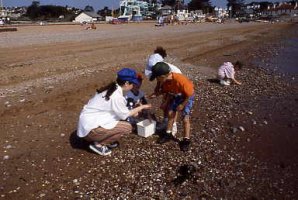|
We offer a range of
geographical activities that cover both human and physical aspects of the
subject. There is a long sandy beach where children can examine beach profiles
and erosion in a hands-on exercise. The geology of the bay is really interesting
with contrasting cliff structures of limestone and sandstone. Fossilised corals
that are 376 million years old can be found on the beach, along with patches of
peat from an ancient forest.
We also take a look at
orientation, using landmarks to map the physical features of the beach.
Tourism plays a major
part in the life of Goodrington Sands. The children investigate the effect of
tourism on the beach and assess the amenities offered using maps and answering
questions. We take a look at the rubbish humans’ leave behind after a day on the
beach and have a brainstorm to gather ideas from the children on how to manage
the area better.
Relevant parts of the
National Curriculum.
 GEOGRAPHY
GEOGRAPHY
Primary
-
Unit 4: Going to the
seaside.
-
To name
and investigate a place.
-
To use
geographical terms.
-
Identify major geographical features.
-
Unit 6: Investigating
our local area.
-
Unit 8: Improving the
environment.
-
Unit 23: Investigating
coasts.
-
Learn
about the physical features of coasts and the processes of erosion and
deposition that affect them.
-
To use
appropriate geographical vocabulary.
-
How do
waves shape coastal environments?
-
What is
a beach?
Secondary:
-
Unit 8: Coastal
environments.
-
What is
weathering? How does weathering affect different types of rocks?
-
To
identify the environmental conditions which cause weathering.
-
To
identify agents of erosion.
-
How is
the Coast shaped by wave action?
-
Identify characteristic landforms.
-
How
wave action shapes the coastal landscape.
-
Unit 13: Limestone
landscapes of England.
-
Unit 19: Tourism- Good
or bad?
-
To
classify different types of holiday.
-
What is
tourism?
-
How
important is tourism as an economic activity?
-
How and
why is the tourist industry changing?
-
What is
the impact of the tourist industry? Good or bad?
|